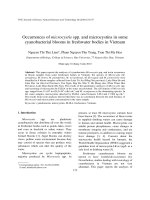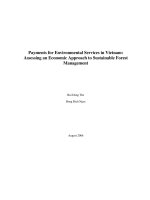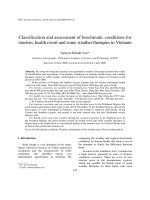SUSTAINABLE TOURISM IN VIETNAM CURRENT s
Bạn đang xem bản rút gọn của tài liệu. Xem và tải ngay bản đầy đủ của tài liệu tại đây (167.32 KB, 8 trang )
SUSTAINABLE TOURISM IN VIETNAM: CURRENT SITUATION AND
FUTURE CHALLENGES
Mã Xuân Vinh
PhD Student in Management of Malaysia University of Science and Technology.
Lecturer at School of Tourism and Hospitality,
HCM City University of Foreign Languages – Information Technology (HUFLIT), Vietnam.
Contact: (0084)962 0144 36/ 918 789156
Abstract:
As many countries increase their efforts to develop tourism in order to boost their economy and to
attain development, the concept of sustainable tourism has become a major issue as well as an important
asset on which these countries have to build on to reach their goal. Since Đổi Mới (Economic Reforms
-1986), tourism became an important sector of Vietnamese economy. The number of international tourists
increased around 15% every year and with 6.6% of GDP in 2016. In this highly dynamic sector,
ecotourism and sustainable tourism are still new activities. In recent years, ecotourism and sustainable
tourism are still theoretical concepts in Vietnam. Divergences between words and practices are still
recurrent.
Social, ecological and economical sustainability often have conflicting goals, and sustainable
tourism is still considered a niche phenomenon. This paper intends to analyze the perception of
sustainable tourism in a global perspective. In the specific context of development process in Vietnam,
we will try to understand what can be the future of sustainable tourism. How should destinations and tour
operators act in order to utilize the opportunities of a future form of tourism which successfully combines
sustainability and profitability requirements with the customers’ interests?
Keywords: ecotourism, sustainable tourism, responsible tourism, Vietnam tourism.
1.
Introduction
The travel and tourism industry is currently one of the largest industries in the world. A number of
domestic and international tourists are steadily increasing and many countries are now seeking to develop
tourism for its many benefits. Tourism is becoming one of the most important social and economic
activities in Vietnam today. The importance of tourism development in Vietnam since the 2000s, the
number of foreign tourists increased around 15.6% per year. Vietnam ranked 75th out of 141 countries in
the WEF’s Travel and Tourism Competitiveness Index in the World Economic Forum (WEF) 2015’s
1
report. Moreover, the Vietnam government has considered tourism as a key economic sector of the
country in 2017.
There is no doubt that tourism sector has become one of the major contributors to development
and is an agent of change for many parts of the world. The strengths of tourism are described in various
forms; as a tool in economic and physical development and as a means to enhance the social and human
capital development and conservation of natural environment (Graci, S. and R. Dodds, 2010). However,
the development of overloaded tourism also brings with it serious long-term problems which, without
careful control and planning, can threaten the society. Therefore, the problem for the tourism industry in
Vietnam today is to develop sustainable tourism. In this light, the relevant stakeholders in tourism
development must be educated and aware about the tourism planning and organization involved
(Okazaki, 2008).
2.
Sustainable Tourism and the Perspective on Sustainable Tourism Development in Vietnam
The term “sustainable tourism” has not yet become a term for tourism marketing in Vietnam. The
first perception was a state of great confusion in the names “ecotourism” and “sustainable tourism”. It is
necessary to map out these terms, and to compare them with international definitions and standards to
understand what they mean in Vietnam. In the Tourism law valid from 1 st of January 2006, the Vietnam
Parliament announced the first official definition of “ecotourism” as: “Ecotourism is one form of tourism
based on nature, closely related with local culture, with the community participation to develop
sustainability (Vietnam Parliament, 2005:3)”. And, the new Tourism law valid from 1 st of January 2018
said “Ecotourism is one form of tourism based on nature, associated with local cultural, with the
participation of the community, combining education on environmental protection (Vietnam Parliament,
2017:2)”. These definitions are only explanation for certain terms that refer to the tourism phenomenon
that exists in Vietnam. These laws did not include any clear ideas on how ecotourism should be operated
or principles to manage these new types of tourism. Since the early 2000s, the term “ecological” and its
derivative “ecological tourism” or “ecotourism” are displayed throughout Vietnam. This confusion is
negative for the image of the quality of tourism in Vietnam. Especially, foreign tourists who are better
informed and more sensitive to ecotourism than most Vietnamese tourists are often disappointed about
the fake ecotourism in Vietnam.
Moreover, Viet Nam has no sustainable tourism concept in the new law, while the United Nations
has designated 2017 the International Year of Sustainable Tourism for Development. “Sustainable
2
tourism should also maintain a high level of tourist satisfaction and ensure a meaningful experience to the
tourist, raising their awareness about sustainability issues and promoting sustainable tourism practices
amongst them” (UNEP and UNWTO, 2005).
“Sustainable tourism should:
-Make optimal use of environmental resources that constitute a key element in tourism development,
maintaining essential ecological processes and helping to conserve natural heritage and biodiversity.
-Respect the social-culture authenticity of host communities, conserve their built and living cultural
heritage and traditional values, and contribute to inter-cultural understanding and tolerance.
-Ensure viable, long-term economic operations, providing socio-economic benefits to all stakeholders
that are fairly distributed, including stable employment and income-earning opportunities and social
services to host communities, and contributing to poverty alleviation” (UNEP and UNWTO, 2005).
Sustainable development not only focuses on environmental protection but also contributes to
preserving indigenous culture, ensuring economic development, and bringing about equitable benefits for
the participants.
However, Vietnam is a participant in global agendas on sustainable development. The tourism
development strategy of Vietnam in the period of 2011-2020 and the vision of 2030 approved by Prime
Minister all have the viewpoint of sustainable tourism development. These include: tourism development
becoming the main economic sector; develop sustainable tourism with the preservation and promotion of
national cultural values, the preservation of the landscape, the protection of the environment, the
maintenance of national security as well as social safety.
On January 16, 2017, the Politburo issued the Resolution 08-NQ / TW on tourism development to
become a key economic sector. This is a milestone in the history of tourism development in Vietnam. It is
also a challenge for a developing country such as Vietnam to develop and define its own concept of
sustainable tourism based on the local situation and uniqueness of tourism resources.
3.
Situation of sustainable tourism development in Vietnam
3
Vietnam tourism is one of the highlights of the economy, with high growth rates and continuous,
constantly expanding in size. According to statistics by Vietnam's Ministry of Culture, Sports and
Tourism, in 2015, tourism contributed some 6.6 percent to the national GDP, creating 2.25 million jobs.
Vietnam earned nearly 338 trillion Vietnamese Đồng (over 15 billion U.S. dollars) from tourism in 2015.
Total international arrivals in 2016 reached 10,012,735 arrivals, increase 26.0% over the same period in
2015 and Vietnam earned nearly 400 trillion VND from tourism (Vietnam National Administration of
Tourism, 2016).
However, the efficiency of tourism activities is not commensurate with the potential and inherent
resources, competitiveness is limited, and the sustainability of the tourist destination is threatened. State
management of tourism are constantly being enhanced but have not met the goal of sustainable tourism
development. In addition, the trend to change the demand of tourists is also a challenge to the
development of sustainable tourism in Vietnam. Roxana Valentina Gârbea (2014) also point out that the
criteria that evaluate tourism attractiveness have changed gradually, the interest in particularities of
tourism supply gradually being replaced by research on the perceptions and motivations of tourists.
Tourists are more experienced and oriented towards practical values as well as being aware of the impact
of travel behavior on the environment and society. Environmental quality becomes an important factor
contributing to the value of tourism. This is a great challenge in terms of perspective, perception and
professional qualification for Vietnamese tourism. If Vietnam's tourism industry does not catch up with
this trend, it will face the risk of lagging, losing market share in the increasingly competitive between
destinations in the region and the world.
Moreover, the issue of environment and climate change is one of the major challenges for
sustainable tourism development in Vietnam. The ecological environment of many tourist destinations in
Vietnam is considered relatively pristine and of high biodiversity. However in recent years, due to the
impact of industrialization, development deficient planning, lack of vision, so the quality of environment
in Vietnam has declined to alarming levels. Most recently, the Taiwanese steel Company Formosa has
released toxic substances to the sea and polluted the marine environment in the central provinces (Việt
Nam News, 2017).
4
Figure 1: Green Lotus Label logo (Source: ESRT)
On the other hand, from 2012, the Vietnam National Administration of Tourism has issued the
criterion of recognizing the “Green Lotus Label” for the tourist accommodations in Vietnam with the
ultimate goal of sustainable tourism development (Decision No.1355/QĐ-BVHTTDL, 12 April 2012).
The Green Lotus Label has 5 grades, from 1 to 5 green lotuses. Criteria include sustainable management;
maximizing the economic and social benefits of local communities; Minimizing negative impacts on
cultural heritage, natural heritage; minimize the negative impact on the environment. The duration of the
Green Lotus Green Tourism label is 3 years (Vietnam Hotel Association, 2013). The number of green
lotus on the label describes the effort in environmental protection and the contribution to sustainable
development of the tourism accommodation service providers. The Green Lotus Label is independent
from the rate of quality (Tourism Quality Star) which is recognized by the Ministry of Culture, Sport and
Tourism which has already applied (UNEP 2015:23-24).
Table 1: Number of tourist accommodation establishments 3-5 stars (2013-2016)
Total
5-star
4-star
Year No. of No. of No. of
Acc rooms Acc
No. of No. of No. of
rooms Acc
rooms
2013
2014
2015
2016
15,385
17,659
24,212
30,624
598
640
747
784
62,002
66,728
82,325
91,250
64
72
91
107
159
187
215
230
20,270
22,569
27,379
29,387
3-star
No. of
Acc
No. of
rooms
375
381
441
442
26,347
26,500
30,734
30,902
(Source: Data compiled by TITC from Hotel Department (VNAT) and Departments of
Tourism and Departments of Culture, Sports and Tourism)
By 2016, Vietnam includes 784 hotels of 3-5 stars; in 2015 only 4.2% (33 hotels and resorts) have
obtained the Green Lotus Label. In the North region, 4 labeled hotels all located in the city of Hà Nội. In
the Central region, 19 hotels of which 50% are in the city and 50% are resorts. In the South, 10 hotels all
located in the city. More than 70% of hotels are located in urban areas and in major cities Hồ Chí Minh
City, Đà Nẳng and Hà Nội. Especially, there is no facilities in the Mekong Delta have receive the labels
(Vietnam National Administration of Tourism, 2015, 2016).
5
In Vietnam, tourist companies do not yet use the term Sustainable tourism but the term
“ecotourism” is present almost everywhere without meaning of real “Eco – tourism”. There is no
certification or label relating to ecotourism qualities for hotels, resorts and guest houses below 3 stars.
In some cases, international NGOs set the normative framework for ecotourism applied to a small
population group and a very limited geographical area, often in the national park. In the specific case of
Tà Lài commune, despite a strong technical, financial, regulatory and training from international NGOs
such as WWF and local authorities, the results are very modest and local ecotourism criteria are not
reached yet. “In brief, the current practice of community – based Ecotourism framework in the Tà Lài
commune, Nam Cát Tiên National Park is unsustainable, (…) It is believed that if they increase
stakeholder engagement with continuous program monitoring and evaluations. Ecotourism management
in the case study will be able to be improve in a well – supported environment and in a sustainable
manner well into the future (Fund and Hitchock, 2000)” (Dương, 2015).
4.
Some solutions for sustainable tourism development in Vietnam
In view these findings, it is necessary to wonder about the future of ecotourism and sustainable
tourism in Vietnam. In the challenges of globalization and international integration, the tourism industry
in Vietnam clearly identifies the viewpoint of tourism development in depth, professionalism, quality and
effectiveness. To develop sustainable tourism, Vietnam needs to implement the following basic solutions:
Firstly, it is necessary to enhance the effectiveness of communication activities, aiming at raising
the awareness of society about the position of sustainable tourism in socio-economic development. It
would be necessary to build an appropriate and effective standard through laws. It is important to
popularize sustainable tourism practices, such as applying green lotus labels to more accommodations in
each region of Vietnam.
Secondly, it should strengthen the policies and technical barriers to prevent imports into Vietnam
technologies, goods and services that harm the environment; it should synchronously implement planning
and investment solutions to actively respond to the impacts of environmental change, including the
development of the tourism industry.
Thirdly, the growth of tourism in the Fourth Industrial Revolution is an advantage. Tourists can
push directly the touristic companies to change their practices by writing some comments on specialized
social network (blogs, facebook, twitter, instagram,…) and evaluation websites as Trip Advisor. The
6
increase of tourism was very high in Vietnam between 1990 and 2016 but majority of the travel
companies did not pay lot of attention to the tourist appreciation. The offer of accommodation and
services is already higher than the average demand for non-specialized tourist establishments (those
below 3 stars) so they must make important promotions to guarantee a minimum rate of filling in normal
period.
Fourthly, Vietnam needs to promote the ideas of enterprises in developing sustainable tourism.
Vietnam should research and develop sustainable and responsible tourism practices for communities,
stakeholders through the guidelines in two important documents: the ILO's "Toolkit for Poverty
Reduction through Tourism" (World Labor Organization) and "Responsible tourism development toolkit"
by ERST (Environmental and Social Tourism Responsibility Project).
Finally, the term sustainable development has a resource dimension associated with the long-term
use and development of the local countryside and local culture (Lars Aronsson, 2000). The role of the
community is very important in sustainable tourism development; they are a part of creating attraction for
tourists. In fact, some people's misconceptions and misconduct have affected visitors such as high prices,
theft, rough handling, tourist insistency, and so on. It is necessary to prevent this problem. Vietnam
should strengthen community-based tourism education, offering educational content about cultural
tourism in public schools, in all levels of training. Consequentially, the tourists will become the
promoters of the Vietnam tourism.
5.
Conclusion
Despites an enormous natural and cultural potential for tourism, Vietnam is still far behind the
many other countries of the Southern Asia region in setting up a true sustainable tourism. In Vietnam, the
general level of environment awareness is still low. The State has not yet taken sustainable tourism as
development priorities, majority of Vietnamese tourism companies have not yet understood long-term
relationship between economic and sustainable, responsible tourism. Sustainable tourism is an
indispensable development trend on a global, so most countries in the world are recognizing the
importance of this trend in their development of tourism. The demand for sustainable tourism
development in Vietnam is urgent. Therefore, policies and guidelines from the government need timely
support. Local authorities should promote their role as a guide for businesses and local communities in
sustainable tourism. The successful development of sustainable tourism can only be assured with the
7
participation of the relevant members and the cooperation of the members in which the interests of each
member should be taken into consideration.
References
[1] Fund K. P. and Hitchcock R. K. .2000. “Step in the formation of community-based resource management institutions and
legal bodies for conservation and development activities in Botswana”. IUCN/SNV CBNRM Support Program.
[2] Graci, S. and R. Dodds. 2010. Sustainable Tourism in Island Destinations. London: Earthscan.
[3] Dương Thị Minh Phương. 2015. “Barriers to Community Engagement in community based Ecotourism Framwork – A case
study of Tà Lài Commune, Nam Cát Tiên National Park in Vietnam”. The International Conference in Finance and Economic
(ICFE), Tôn Đức Thắng University, Hồ Chí Minh City, Vietnam, June 4th-6th, 2015.
[4] Lars Aronsson. 2000. The development of sustainable tourism. Continuum.
[5] Okazaki, E.2008. “A Community – Based Tourism Model: Its Conception and Use”. Journal of Sustainable Tourism, 16(5):
pp.511-529.
[6] UNEP, 2015. “Assessment Report: Sustainable Public Procurement Status in Vietnam”. Project “Stimulating the Demand
and Supply of Sustainable Products through Sustainable Public Procurement and Ecolabelling” (Sppel). Hanoi, April 2015, 32
p.
[7] UNEP and UNWTO. 2005. Making Tourism More Sustainable - A Guide for Policy Makers, p.11-12.
[8] Valentina GÂRBEA. 2014. Tourist Attractiveness of the Urban Environment in Moldavia. Management & Marketing,
volume XII, issue 1/2014.
[9] Việt Nam News, Locals compensated for fish kill, October 20th, 2017.
Websites:
[10] “Tourist accommodation establishments (2000 – 2015)”,
March 18, 2016
[11] “Green Lotus label to advance sustainable tourism
development”, 2 July 2015.
[12] />
8









